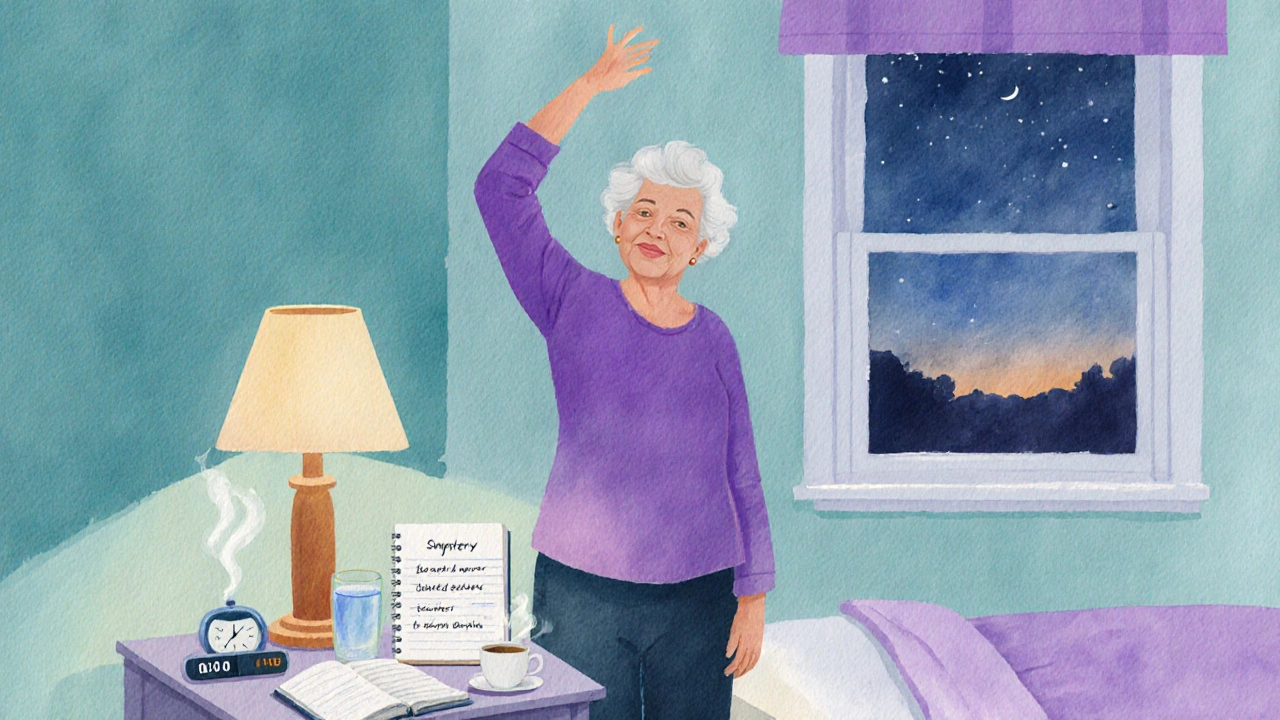Fibromyalgia Symptom Tracker by Age
As you age, fibromyalgia symptoms often evolve in predictable patterns. Understanding these changes can help you prepare and adjust treatment strategies accordingly.
| Age Group | Pain | Sleep Quality | Fatigue | Cognitive Fog | Common Co-morbidities |
|---|---|---|---|---|---|
| 40-49 | Moderate, localized | Intermittent insomnia | Variable, often manageable | Present, mild | None or mild depression |
| 50-59 | Increasing, spreads to hips/knees | Frequent awakenings | Persistent, worsens with activity | More noticeable, affects work | Osteoarthritis, hypertension |
| 60+ | High, often coincides with arthritis | Chronic fragmented sleep | Severe, daily | Significant, impacts memory | Osteoporosis, cardiovascular disease |
As you age, pain may spread and intensify due to muscle loss and joint wear. Focus on gentle exercises and consider discussing medication adjustments with your doctor.
Sleep disruption worsens with age. Implement sleep hygiene practices and discuss potential medication side effects with your healthcare provider.
Cognitive fog may become more persistent with age. Engage in brain-stimulating activities and maintain social connections to support mental health.
Your current age group (50-59) shows increased pain spreading and frequent sleep disruptions. It's recommended to incorporate low-impact exercise, review medications with your doctor, and establish a consistent sleep routine.
Important Note
Always consult with your healthcare provider before making any changes to your treatment plan. This tool provides general information and is not a substitute for professional medical advice.
Living with Fibromyalgia is a daily battle of aching muscles, restless nights, and brain‑fog. But the story doesn’t stay the same as you get older. Age brings hormonal shifts, bone density changes, and a different set of life stressors-all of which can reshape how the condition feels. This guide walks you through the most common ways symptoms evolve, what to watch for, and practical steps to keep quality of life steady as the years add up.
Key Takeaways
- Pain may spread or intensify after 50, often because of decreased muscle mass and joint wear.
- Sleep problems tend to worsen, making fatigue and cognitive dysfunction more noticeable.
- Co‑existing conditions like osteoarthritis become common, requiring medication adjustments.
- Gentle exercise, targeted sleep hygiene, and regular medication reviews are the backbone of senior‑friendly management.
- Keeping a symptom diary helps doctors tailor treatment as your body changes.
How Fibromyalgia Evolves With Age
When you’re in your 30s or 40s, Aging is still a distant concept. The nervous system is relatively resilient, and the body can often compensate for the heightened pain signals that define fibromyalgia. Once you cross the 50‑year mark, several physiological shifts kick in:
- Muscle mass loss - sarcopenia reduces the cushioning effect muscles provide for tender points.
- Bone density decline - osteoporosis or osteopenia can add joint pain that mimics or aggravates fibromyalgia.
- Hormonal changes - especially in women, estrogen drops can heighten pain perception.
These factors don’t create a brand‑new disease; they simply amplify existing signals. The result is often a broader distribution of chronic pain and a higher reliance on pain‑modulating medication.
Common Symptom Shifts by Decade
| Age Group | Pain | Sleep Quality | Fatigue | Cognitive Fog | Common Co‑morbidities |
|---|---|---|---|---|---|
| 40‑49 | Moderate, localized | Intermittent insomnia | Variable, often manageable | Present, mild | None or mild depression |
| 50‑59 | Increasing, spreads to hips/knees | Frequent awakenings | Persistent, worsens with activity | More noticeable, affects work | Osteoarthritis, hypertension |
| 60+ | High, often coincides with arthritis | Chronic fragmented sleep | Severe, daily | Significant, impacts memory | Osteoporosis, cardiovascular disease |

Sleep and Fatigue: The Double‑Edged Sword
Sleep disruption is a hallmark of fibromyalgia at any age, but older adults face additional hurdles:
- Reduced REM sleep - natural aging cuts REM cycles, making it harder to reach the restorative phases that ease pain.
- Nocturia - waking up to use the bathroom fragments sleep, leading to next‑day exhaustion.
- Medication side‑effects - sedatives prescribed for anxiety can cause morning grogginess, especially when kidney function declines.
Practical sleep hygiene tips for seniors:
- Keep bedroom temperature between 60‑67°F; colder rooms improve deep sleep.
- Limit caffeine after 2p.m. and avoid heavy meals close to bedtime.
- Establish a wind‑down routine: gentle stretching, dim lighting, and a short meditation.
- Consider a sleep study if apnea is suspected; untreated apnea spikes pain perception.
Cognitive Effects - The Evolving "Fibro Fog"
Brain‑fog, officially called cognitive dysfunction, can feel like a mental cloud that makes simple tasks feel impossible. In younger patients it’s often episodic, but older adults notice a steadier decline because:
- Age‑related reductions in processing speed compound the slower neurotransmission already caused by fibromyalgia.
- Medication burden (multiple prescriptions) can impair attention.
- Sleep loss, as described above, directly harms memory consolidation.
Simple cognitive‑boosting habits work well:
- Play brain‑training apps for 10minutes daily.
- Keep a daily to‑do list; crossing items off reinforces short‑term memory.
- Stay socially active - conversation is a natural mental workout.
Co‑existing Conditions and Medication Adjustments
By the time you’re in your 60s, many fibromyalgia patients also manage osteoarthritis, hypertension, and sometimes mild cognitive impairment. These overlap in three ways:
- Symptoms overlap - joint pain from arthritis can be mistaken for a fibromyalgia flare.
- Medication interactions - NSAIDs used for arthritis can irritate the stomach, while duloxetine (a common fibromyalgia antidepressant) may raise blood pressure.
- Treatment priorities shift - pain relief may take a backseat to protecting cardiovascular health.
Regular medication reviews with a physician or pharmacist are crucial. Look for:
- Lower dosages of opioids, if any, because older adults are more prone to falls.
- Switching to duloxetine or milnacipran, which also treat depression and can aid sleep.
- Adding calcium‑vitaminD supplements if bone density is low.

Lifestyle Strategies Tailored for Seniors
Exercise remains the single most effective tool, but the type and intensity must adapt:
- Low‑impact cardio - walking, water aerobics, or stationary cycling for 20‑30minutes, five days a week.
- Strength training - resistance bands or light dumbbells twice weekly to combat sarcopenia.
- Flexibility - daily gentle yoga or tai‑chi improves range of motion and reduces stiffness.
Nutrition also plays a role. Anti‑inflammatory foods (fatty fish, leafy greens, berries) can lower overall pain scores by up to 15% according to a 2023 longitudinal study of 1,200 fibromyalgia patients over five years.
Finally, mental health shouldn’t be an afterthought. Even mild depression can amplify pain perception. Simple actions like scheduling weekly phone calls with friends, joining a local support group, or practicing mindfulness for ten minutes each morning keep mood-and pain-under control.
Quick Checklist for Managing Fibromyalgia in Later Life
- Schedule a comprehensive medication review at least once a year.
- Track pain, sleep, and fatigue daily using a simple notebook or app.
- Incorporate low‑impact cardio and strength work three to five times weekly.
- Adopt a sleep‑friendly routine: cool room, limited caffeine, consistent bedtime.
- Prioritize anti‑inflammatory foods and stay hydrated.
- Stay socially connected and practice mental‑stimulation activities.
Frequently Asked Questions
Does fibromyalgia get worse after 60?
Most people notice a shift in symptom pattern rather than a straight line of worsening. Pain may spread, sleep becomes more fragmented, and co‑existing conditions like arthritis add new challenges. With proper exercise, medication tweaks, and sleep hygiene, many seniors keep pain at manageable levels.
Can I stop taking my fibromyalgia meds when I turn 65?
Never stop medication without consulting a doctor. Age‑related kidney or liver changes can require dose adjustments, but abrupt cessation often leads to rebound pain and mood swings.
Is exercise safe for someone with severe joint pain?
Yes, when it’s low‑impact and tailored. Water‑based activities reduce joint stress, and starting with very short sessions (5‑10minutes) helps the body adapt without overloading painful joints.
What are the best sleep aids for older adults with fibromyalgia?
Non‑pharmacologic options are first‑line: consistent bedtime, CBT‑I (cognitive‑behavioral therapy for insomnia), and melatonin (0.5mg) if needed. Prescription sleep meds should be used sparingly because they increase fall risk.
How often should I see my doctor about fibromyalgia as I age?
At least twice a year for a full review, plus extra visits when you notice new or worsening symptoms. Regular check‑ins help catch medication side‑effects early.


Write a comment